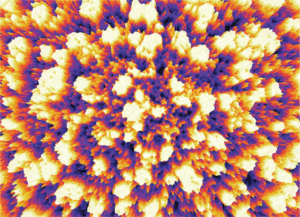The term active matter might refer to something quite extraordinary such as, for example, dark matter. But what if I told you that such a term is used to describe very mundane things, such as flocks of birds or schools of fish?  Active matter systems are composed of self-propelled elements and characterised by complex behaviours. Recently, the interest in active soft matter systems has grown significantly, with bacterial swarms and self-propelled particles being the two main foci of work in the area.
Active matter systems are composed of self-propelled elements and characterised by complex behaviours. Recently, the interest in active soft matter systems has grown significantly, with bacterial swarms and self-propelled particles being the two main foci of work in the area.
In this publication the authors are particularly interested in the less explored case in which two active components – faster and slower particles – are mixed. This would correspond, for example, to a mixture of bacteria with different speeds; or, in the macroscopic world, a scenario where zebras are being hunted by lions. They carry out Brownian dynamics simulations adapted to active matter, to find out that a segregation into condensed and gas-like phases, each composed of both fast and slow particles, takes place in such systems. Moreover, the composition of the condensed phase is highly dependent on the difference of activity between the two components. When the difference in speed between fast and slow particles is significant, the core of the condensed phase is composed of slow particles and the fast particles remain in the outer shell. If the speed is similar, then fast particles can be found as well as slow particles in the core of the condensed phase. The insights presented in this work are valuable to understand further multicomponent active matter already present in Nature or to engineer new active systems and harness the potential of their complex behaviour for diverse applications.
Comments from the authors:
- Multicomponent active matter composed of mixtures of particles with distinct active driving forces remains largely unexplored
- Active matter mixtures of fast and slow self-propelled colloids (Active Brownian Particles), is a useful way to investigate what quantities (if any) equilibrate in an active system
- The behaviour of an active material can be tuned by the introduction of additional distinct active species
- For binary active/active mixtures, a concentration weighted average of the activities of each species controls motility-induced phase separation (MIPS)
- For slow/fast activity ratio near 0, and low fast particle activity, particle participation in the dense phase is significantly affected due to mixing
- For slow/fast activity ratio near 1, and high fast particle activity, each species participates in the dense phase as if it were a monodisperse system
- Theoretical approaches for multi-component active mixtures will provide progress towards an equation of state for active matter
Citation to the paper: Heterogeneous versus homogeneous crystal nucleation of hard spheres, Soft Matter, 2020, 16, 1967-978, DOI: 10.1039/c9sm01799b
To read the full article click here!
Did you know that Soft Matter has an Active Matter themed collection? Click here to check out more papers!
About the web writer
Dr Nacho Martin-Fabiani (@FabianiNacho) is a Vice-Chancellor’s Research Fellow at the Department of Materials, Loughborough University, UK.










